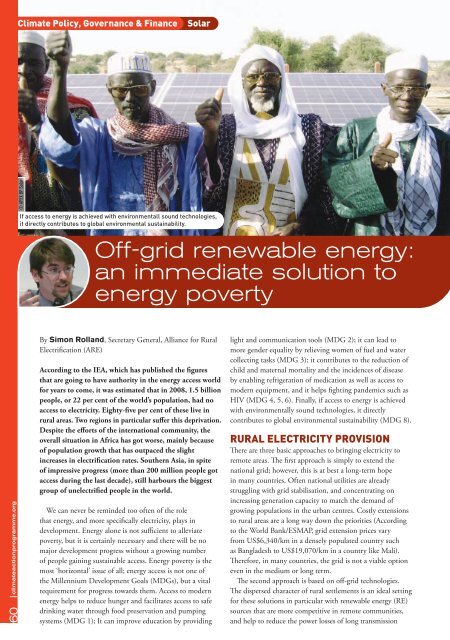Climate Action 2011-2012
Create successful ePaper yourself
Turn your PDF publications into a flip-book with our unique Google optimized e-Paper software.
climate policy, Governance & Finance<br />
solar<br />
© APEX BP Solar<br />
If access to energy is achieved with environmentall sound technologies,<br />
it directly contributes to global environmental sustainability.<br />
Off-grid renewable energy:<br />
an immediate solution to<br />
energy poverty<br />
60 climateactionprogramme.org<br />
By Simon Rolland, Secretary General, Alliance for Rural<br />
Electrification (ARE)<br />
According to the IEA, which has published the figures<br />
that are going to have authority in the energy access world<br />
for years to come, it was estimated that in 2008, 1.5 billion<br />
people, or 22 per cent of the world’s population, had no<br />
access to electricity. Eighty-five per cent of these live in<br />
rural areas. Two regions in particular suffer this deprivation.<br />
Despite the efforts of the international community, the<br />
overall situation in Africa has got worse, mainly because<br />
of population growth that has outpaced the slight<br />
increases in electrification rates. Southern Asia, in spite<br />
of impressive progress (more than 200 million people got<br />
access during the last decade), still harbours the biggest<br />
group of unelectrified people in the world.<br />
We can never be reminded too often of the role<br />
that energy, and more specifically electricity, plays in<br />
development. Energy alone is not sufficient to alleviate<br />
poverty, but it is certainly necessary and there will be no<br />
major development progress without a growing number<br />
of people gaining sustainable access. Energy poverty is the<br />
most ‘horizontal’ issue of all; energy access is not one of<br />
the Millennium Development Goals (MDGs), but a vital<br />
requirement for progress towards them. Access to modern<br />
energy helps to reduce hunger and facilitates access to safe<br />
drinking water through food preservation and pumping<br />
systems (MDG 1); It can improve education by providing<br />
light and communication tools (MDG 2); it can lead to<br />
more gender equality by relieving women of fuel and water<br />
collecting tasks (MDG 3); it contributes to the reduction of<br />
child and maternal mortality and the incidences of disease<br />
by enabling refrigeration of medication as well as access to<br />
modern equipment, and it helps fighting pandemics such as<br />
HIV (MDG 4, 5, 6). Finally, if access to energy is achieved<br />
with environmentally sound technologies, it directly<br />
contributes to global environmental sustainability (MDG 8).<br />
RuRal electRicity pRovision<br />
There are three basic approaches to bringing electricity to<br />
remote areas. The first approach is simply to extend the<br />
national grid; however, this is at best a long-term hope<br />
in many countries. Often national utilities are already<br />
struggling with grid stabilisation, and concentrating on<br />
increasing generation capacity to match the demand of<br />
growing populations in the urban centres. Costly extensions<br />
to rural areas are a long way down the priorities (According<br />
to the World Bank/ESMAP, grid extension prices vary<br />
from US$6,340/km in a densely populated country such<br />
as Bangladesh to US$19,070/km in a country like Mali).<br />
Therefore, in many countries, the grid is not a viable option<br />
even in the medium or long term.<br />
The second approach is based on off-grid technologies.<br />
The dispersed character of rural settlements is an ideal setting<br />
for these solutions in particular with renewable energy (RE)<br />
sources that are more competitive in remote communities,<br />
and help to reduce the power losses of long transmission












